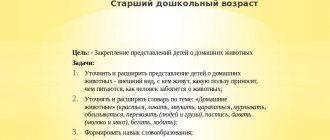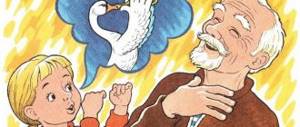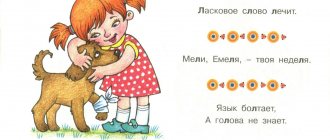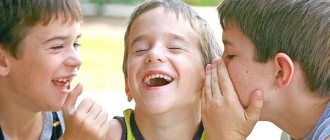Summary of a lesson on speech development in 6th grade “Letter to the boy Onfim in the 13th century.”
Learning new material.New material is compiled during group work with a dictionary, inductive conversation, individual communication, and recording the research results on a worksheet.
1) Working with concepts.
— The letter belongs to the epistolary genre. Epistole - (Latin epistole - letter) a literary work, usually in the form of a letter, which sets out the author’s opinions on a particular subject. Any genre of oral and written speech involves the use of concepts and terms. What terms are associated with the epistolary genre - the genre of writing?
2) Search work in groups with an explanatory dictionary.
— Task for the first
groups: find out the meaning of words
address
(place where the letter is sent);
addressee
(the one to whom the postal item is addressed (person or institution);
addressee
(the one who sends the postal or telegraphic item (person or institution).
— Assignment for the second
groups: find out the meaning of words
letter
(letter, notification, message on paper, sheet, written speech, conversation sent from one person to another);
envelope
(a square or rectangular paper bag into which a letter is placed).
— Task for the third
groups: find out the meaning of the words
postman
(a person who delivers mail to a specified address);
index
(digital, symbolic designation of a locality).
— Group report on the work done.
— What new knowledge did you gain while working with dictionaries?
3) Inductive conversation.
- What types of letters do you know?
Write them down on your worksheet. (Letters are different: friendly, personal, official, business, congratulatory, thank you, letters to the newspaper )
Supplement your entry with information from the slide
(slide)
- Why and to whom do they write letters? (Most often we write letters to loved ones, acquaintances, relatives to share our thoughts, feelings, experiences).
—
What is missing from short email messages or mobile calls?
(They lack warmth and sincerity, because when you read a letter, it’s as if you’re talking to someone close to you).
— What style of speech will you use to write to a friend?
4) History page. Personal message.
Class assignment: Listen to the message, formulate new knowledge.
A trained student talks about the heyday of the epistolary genre in the 18th and 19th centuries: In the 18th and 20th centuries, letters were the only written means of communication. Personal letters to friends, family, acquaintances. Business – to various institutions. An example of the epistolary genre are the letters of classical writers, which we can read in collected works. There are even works created in the form of letters. For example, Karamzin, after his trip to Europe, published “Letters of a Russian Traveler.” It is interesting to read the letters of I.S. Turgenev, L.N. Tolstoy, which contain information about our region. Leo Tolstoy, when he was visiting the Shablykin landowner N. Kireevsky, wrote to his wife, Sofya Andreevna: “Today we are again going to the field we are leaving, and, to tell the truth, what I will not say here - I don’t want to go at all, but there is nothing to do; Having come so far, you need to take advantage of as much as you can. To tell the truth, this hunting world and the old man’s world are dearer to me than hunting. I don’t regret that I went, and I couldn’t be happier.” About the personality of Kireevsky, L.N. Tolstoy wrote: “Very kind, courteous, equal with everyone, simple in every sense, but, apparently, an honest, kind, sensible person, for whom it is easy to be in character, position, and wealth honest." And two weeks later, Tolstoy, speaking about Kireyevsky, admits in a letter to Fet: “I’ll tell you orally what a delight this is - he himself and this whole world, which has already passed into legend, and then reality.” Thus, letters are evidence of time, telling us about the time and people who lived then.
5) Intermediate reflection.
-What new did you learn from this message?
6) Letter composition.
(Write in notebook)
— What parts does any text consist of? (introduction, main part, conclusion).
- Think and write down the composition of the letter.
Greeting and (or) address - the title or name of the person to whom the letter is intended.
Introduction - an apology, questions reflecting interest in the life of the addressee, courtesy addressed to him, wishes.
The main part is the presentation of information of interest to the addressee.
Conclusion - an expression of respect, love, devotion, reverence, farewell, etc.
Signature. Date of.
—Which of these elements are unique to writing?
— How are they prepared?
(The text of the letter begins with a red line and with a capital letter. After the text of the letter there is a final politeness formula, signature and date. It is better to write the final politeness formula and signature on the right, below, and the date at the bottom left).
Lesson on developing coherent speech in 6th grade
Lesson on the development of coherent speech in 6th grade.
Topic:
Interior. Description of the premises.
- Lesson type:
lesson in the formation of new knowledge
- Lesson form
: conversation using presentation
- Technical requirements for the lesson:
Power Point program, computer, multimedia projector, screen
The purpose of the lesson
knowledge formation - organization of work on mastering techniques and methods for describing the interior
Tasks:
- educational:
introduce students to the concept of “interior”; give an idea of the types and components of the interior; teach to describe a room; enhance cognitive activity;
- developing:
develop creative abilities and observation skills; develop communication skills for working in groups; develop interest in cultural heritage, develop coherent speech;
- educational:
education of the sense of taste and color; to cultivate a common culture and language culture.
Lesson structure
combines the stages:
- organizational;
- goal setting;
- introduction of knowledge and concepts;
- conversations;
- generalizations, primary consolidation;
- independent work;
- summing up;
- definition of homework and instructions on how to complete it.
Types of jobs:
Observation, conversation on issues, reasoning, recording, drawing up a plan, selecting material according to the plan, telling a story according to the plan.
During the classes
- Organizing time. 2. Goal setting.
When returning home from somewhere, we always talk about what we learned. But most often our story begins with a description of the place where we were. How to structure our story correctly? What should you pay attention to? What words to choose. This is what we will learn in today's lesson.
- Introduction of knowledge and concepts.
A fashionable profession today is an interior designer. What is “interior”? Let's turn to the screen. (Slide No. 3)
Let's write down the definition.
— What types of interior can be distinguished by purpose?
(Residential and public) What types are each of them divided into? (Antique and modern)
(Slides No. 5,6,7,8)
— What does the interior include? (Slide No. 4)
(Walls. Ceilings. Wall decoration. Modeling. Wood carvings. Furniture. Lighting fixtures. Carpets, etc.)
— Is it possible to determine from the interior who the owner of the room is? (Slide No. 6) (You can. The boy’s room has a nautical theme, furniture in the form of a steering wheel. The girl’s room has white furniture, pink walls, Barbie stickers)
So. The interior can tell us about an era, about culture, about a person’s character.
Many artists depicted the interior in their paintings.
-Why did they do this? (Slide No. 9) (In interior painting, the artist must reflect the era, life, culture, interests, social status and profession of a person, various shades of his feelings and moods.)
Artists who depicted the interior (Slide No. 10)
- What kind of interior is in Vasnetsov’s painting? (Slide No. 11) (Antique, residential)
- In the painting by S. Zhukovsky? (Slide No. 12) (Antique, residential)
- In the painting by P. Pushkarev? (Slide No. 13) (Antique, public)
- In the painting by S. Kustodiev? (Slide No. 14) (Antique, public)
- In the painting by A. Pereverzeva? (Slide No. 15) (Modern, residential)
4. Conversation stage.
Let's take a closer look at the painting “North”. (Slide No. 15)
- Why is the picture called that?
- What is shown in the picture?
- What attracts our attention first?
- What does the room look like in A. Pereverzeva’s painting?
- What interior details did the artist include in her painting?
- What signs of the northern village did the artist depict in the painting?
Let's look at the heroes of the picture.
- Who are the heroes of the picture?
- How are the women dressed?
- What are they doing?
- What details indicate that the conversation is leisurely?
- What is the child doing?
- What is the mood in the room?
- Stage of generalization, primary consolidation
Northern summer is short and cool. Most of the year it is cold, night and white snow. Therefore, people strive to at least retain a part of the bright summer days in the house. In A. Pereverzeva’s painting we see such a room in a northern village hut.
Let's draw up a plan for describing the picture. (Slide No. 18)
- Summer day in a northern village.
- Room (walls, table, windows, floor, bed and other interior items).
- The heroes of the picture.
Women (appearance, clothing, occupation)
- Child (age, posture, facial expression).
Let's write the plan in a notebook.
Let's select the words necessary for the description. (Log walls, high table, wooden chairs, white tablecloth, large windows, light curtains, long geraniums, iron bed, bright red pillowcases, fluffed pillows, patchwork multi-colored blanket, white lace valance, bright rugs, samovar, bowl of jam, pies . Multi-colored sundress, red sundress, red headscarf, white blouses, bare feet. Blue shirt. Slowly, sedately, calmly, drinking tea)
6. Independent work stage
Looking at the picture, using supporting words, verbally describe A. Pereverzeva’s picture “North” (Slide No. 19)
7. Lesson summary.
- What new did we learn in class today?
- Why do artists often depict interiors in such detail in their paintings?
8. Homework assignment.
Orally describe a modern residential or public interior. Refer to the plan. You can use photographs, paintings by artists, or personal observations.
Speech development lessons in 6th grade
Thematic planning
6th grade
| 1 | Module: “Text. Subject. Main idea" (5 lessons) | ||
| to know | learn | ||
|
| ||
| 2 | Module: “Speech styles. Distinguishing texts of different styles" (6 lessons) | ||
| to know | learn | ||
|
| ||
| 4 | Module: “Description. Learning to draw with words" (5 lessons) | ||
| to know | learn | ||
|
| ||
| 5 | Module: “Reasoning. Learning to be persuasive" (5 lessons) | ||
| to know | learn | ||
|
| ||
| 7 | Module: “Narration. Learning to tell interesting stories" (5 lessons) | ||
| to know | learn | ||
| Tell stories expressively while keeping listeners' attention | ||
The main goal of speech development lessons in the 6th grade is to give students an idea of the stylistic diversity of texts, to teach them to distinguish texts of different styles, to take into account the linguistic means of different styles, as well as to distinguish texts by type, to have an idea of the structure of descriptive texts, narration and reasoning.
| |
| 1 | Text. Text features |
| 2 | Types of text |
| 3 | Subject. Main thought |
| 4 | Text structure. |
| 5 | Module test |
At the first lesson
Students are asked to do research work. It must be taken into account that they have already encountered the concept of text before and, of course, have an intuitive idea of what a text is. Therefore, they can put forward a hypothesis about what the text is and name its features. To do this, they are asked to choose from the proposed options (words related to the topic; sentences not related to each other; several sentences related to each other), select what they consider to be the text and explain their choice. Having explained their choice, students thus formulate a definition of the text, listing the characteristics of the text (coherence, semantic generality, relative completeness). Then they are offered 5 fragments for analysis. Their task is to evaluate by. The results are entered into the table. The results are being discussed. To conclude, students are offered Lev Losev’s poem “Text is Fabric.” This type of work is best done in groups.
The purpose of the second lesson
– give an idea of different functional and semantic types of speech. Students are offered three pictures: one depicts just a cat, the other a comic book with a cat, the third an abstraction, but in the same color scheme as in the previous pictures. Students are asked to write down in 5-6 sentences what they see in these pictures. Then the texts are selectively read and students determine what is common and what is different in these texts. Having united in groups, they summarize what was said, find the features of each type of text, and write it down in a table. The question they answer in the form of a conclusion is: “Why is this happening? Why did the texts turn out so different?” We come to the conclusion that it depends on the purpose of the statement: to tell (narration), describe (description) or reason (reasoning). As reinforcement exercises, it is proposed to determine by individual words what type of text the text from which the words were taken belonged to.
The main goal of the third lesson
– teach children to identify and formulate the theme and main idea of texts of different styles and types. It is important at this stage to make clear the difference between a topic and a main idea. Usually, as experience shows, this causes difficulties for children. At home, students prepared texts of different types on the same topic. Possible tasks: 1) find in the text a sentence that most accurately reflects the main idea of the text; 2) formulate 3 statements in the text, one of which does not correspond to the content (then they exchange it, the task is to find the one that does not correspond); 3) choose from the proposed formulations the one that most accurately reflects the main idea of the text. When students see a sufficient number of examples of how the main idea of a text is formulated, they are asked to independently formulate the main idea of the texts they read. At the end of the lesson, you can ask what was the main idea of the lesson.
Fourth lesson
dedicated to the structure of the text. Students receive a text cut into sentences. The task is to collect and then answer the question of why they made this particular decision, what words suggest that the sentences are connected in this particular way. As a result, students themselves formulate the main ways of connecting sentences in the text (cognates, word forms, conjunctions, pronouns). After which the students are presented with a trick text: the sentences are grammatically connected, but not meaningfully. We come to the conclusion that semantic coherence is also an important feature of the text. Then students are tasked with finding connections between sentences in the reconstructed texts. Task type: 1) find a sentence that develops the thought expressed in the 5th sentence; 2) find the sentence(s) that describe the consequences of the action described in the 6th sentence.
| |
| 1 | How do texts differ in different styles? |
| 2-3 | Scientific and journalistic styles of speech |
| 4 | Formal business style of speech |
| 4 | Artistic style and style of fiction |
| 5 | Test |
The purpose of the first lesson
This block not only demonstrates to children that texts differ in style, but leads them to understand the appropriate style when composing their own text - this is the basis of communicative success. This can be done by drawing a parallel with fashion styles. Students are asked to look at two pictures: 1) a girl in a tracksuit at a ball among ladies and gentlemen in elegant outfits and 2) a girl in a ballgown on the playground in the yard. The question asked of the class is: “What’s wrong? Why is it funny? Together, the class comes to the conclusion that the girl in both the pictures chose the wrong style of clothing and that in order to avoid getting into an awkward situation, you need to be able to choose the right style that matches the situation. Let's draw a parallel with speech styles. Then the students choose roles, and their task is to talk about the weather, an incident on the street or describe nature, choosing language means appropriate to the role/speech situation. Support words are given as a hint, but students themselves determine for which situation which words and expressions are appropriate.
In the second and third lessons
Scientific and journalistic styles of speech are reviewed. In order for students to understand the linguistic features of the scientific style of speech, they are offered the following task: to translate simple proverbs from scientific language into ordinary language. To summarize, students are asked to translate a well-known fairy tale into an official business, scientific or journalistic style of speech.
Fourth lesson
– identify the features of official business style. Work in groups. Each group is given a piece of the school charter. The task is to analyze: find in the text the translation to the office. – business style of speech, answer questions. Group 1 – how sentences are constructed; Group 2 – vocabulary; Group 3 – how the text is structured. Why do you need a formal business style of speech? Assignment: formulate a charter for the school of the future/school of dreams.
In the fifth lesson
Students are tasked with defining the difference between the concepts of “artistic style” and “style of a work of art.” This is best done using the example of a specific literary work, where different styles of speech are used.
| |
| 1 | What can be described |
| 2 | Interior. What can you tell about a person from his room? |
| 3 | How to make a description expressive. Comparisons. Metaphors |
| 4 | Composition |
| 5 | Work on mistakes |
The goal of this block is not just to learn to describe the interior using expressive language, but to learn to be attentive to details. Students are given the opportunity to express themselves.
At the first lesson
Students become familiar with how different descriptive texts can be: landscape, portrait, interior, and analyze the texts.
In the second lesson
Students are offered for analysis several descriptions of a room from works of art: “Mumu” by Turgenev (Gerasim’s room), “Oblomov” by I.A. Goncharov (Oblomov’s room), Gogol’s “Dead Souls” (Sobakevich’s house, Manilov). The task is to write down the “telling” details and sign opposite each one what conclusion can be drawn about the person’s character. We draw a conclusion about the significance of the interior in a work of art.
Third lesson
- This is a lesson-creative workshop. The main task is to penetrate into the essence of the metaphor, to try your hand at creating metaphors and comparisons. Analysis of the poem. Inventing your own associations. What is it like: 1) Describe, using a metaphor or simile: 1) the flame of a fire; 2)
In the fourth lesson
writing an essay. To have motivation, it is important to formulate the task correctly. By describing the room, they characterize the character. Here is an example assignment.
When working on mistakes, be sure to read out the essays of those children who express such a desire. While listening to the text, students try to guess who is the owner of the room.
| |
| 1 | Journalistic style. Problematic question. Structure of reasoning: thesis and argument |
| 2 | The art of argumentation. Preparing for the debate |
| 3-4 | Debate |
| 5 | Essay-reasoning |
At the first lesson
— work with texts of journalistic style. Assignment: formulate a topic, a problem - a question that the author asks the readers.
Second lesson
– enter into dialogue with the authors. To tell your opinion. For this
Three cut texts (on sheets of different colors). In one direction - the thesis, in the other - arguments. Formulate what topic the texts are on, formulate the problem in the form of a question. Let's move on to analyzing the arguments. What they are: they formulate themselves. Then Smekhov's text. Add. Listen to a short speech - identify the arguments. Then they come up with the arguments themselves for the theses (in pairs).
Third and fourth lessons
debates are taking place on technology. Prepare in advance. A text with a problem is given. The task is to prepare the pros and cons. The lesson is limited in time, and only 6 players will have time to speak, but this does not mean that the rest are inactive: they receive evaluation sheets that they must fill out during the debate.
The last lesson is writing an essay (composition-reasoning) based on a quote. The task is to formulate the problem and provide arguments to support the thesis.
| |
| 1 | What parts does a story consist of? |
| 2 | How to make a story interesting |
| 3 | Telling stories orally |
| 4 | Composition |
| 5 | Work on mistakes |
On the first
In the lesson, students become familiar with the structure of a narrative text. The work takes place in groups. Each group is given a Bidstrup comic strip cut into pieces. The task is to arrange them in the right order and explain your choice. If you were to describe in words what is drawn on this comic, what type of speech would you get? How many paragraphs would there be in this text, make an outline. What role does each part of the text play in the development of the plot? Sign opposite each part. Together with the students, we conclude that in any story there is something that starts the conflict/situation (commencement), events that follow (action development), a situation where the highest tension is achieved (climax) and subsequent events (denouement) .
Second and third
Lessons are aimed at developing students' oral speech, imagination and creative thinking. A story based on pictures. In the second lesson, watch video stories (Baron Munchausen): what makes his story interesting and exciting. Formulate the commandments of a skilled storyteller. They themselves try to tell the story using pictures. For the fourth lesson, a series of pictures and an instructive story are prepared. Assignment for students: 1) determine the topic; 2) determine the main idea; 3) write down what means of expression were used. Work in groups.
In the fourth lesson
You are asked to write a narrative essay. Compose a story based on the ending or the beginning.




